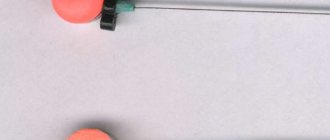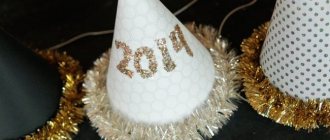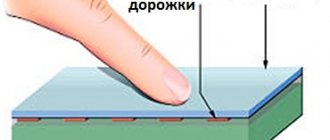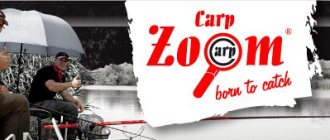During feeder fishing, sluggish and inconspicuous bites often occur, often invisible to the angler’s eye. In order for them to be realized, self-hookers were invented, which are currently used both for fishing with classic donks and for more advanced feeder fishing. There are currently a lot of self-hookers; it is sometimes difficult for an angler to understand how this design works and how to make a self-hook for feeder fishing with his own hands.
To understand what a feeder self-cutter is, you need to understand its structure, operating principle and types. The device is auxiliary when fishing with a feeder and does not represent a full-fledged self-hooking tackle.
Self-cutting device for feeder
A classic automatic feeder cutter - homemade or factory-made - consists of the following main elements:
- Support post - serves to fasten the self-cutting device in the soil of the bank;
- Rocker arms - designed to fix the rod handle;
- Springs - when there is a bite and the trigger mechanism is activated, under the influence of elastic force, it gives the feeder itself a jerky upward movement - a hook;
- Trigger mechanism - designed to trigger the spring-loaded rocker arm at a certain tension of the fishing line by the fish.
Such an automatic hook hook for fishing, when properly configured, virtually eliminates idle triggering and ensures the maximum number of productive hooks. In addition to fishing stores, you can purchase it on various Internet portals.
In addition to store-bought self-cutters for feeders, homemade ones have recently become widespread. They are in no way inferior to, and sometimes even superior to, their factory counterparts. There are plenty of videos and drawings on the Internet that make the process of creating a device easier.
Option 1
The self-hook is designed for use with a fishing rod or spinning rod and the spring properties of the rod. During a bite, the bent rod is released by the hooking mechanism, as a result, the fish is automatically hooked without any action from the fisherman.
In the image we can see a general diagram of the operating principle of such a system.
To connect the parts of the self-undercutter structure, wire bushings are used, which are soldered, or bolts - you can choose one of these solutions.
There are different options for the material - steel with or without galvanization, preferably brass. In general, whatever is at hand.
All the elements of the homemade product need to be connected and at the same time ensure that the moving parts should move easily and not get stuck anywhere. You can put a minimum amount of machine oil on them.
Now we have one part of a homemade auto hook. You can make a holder for installing a fishing rod or spinning rod with your own hands or buy a ready-made glass. Or take some other object of a suitable shape to attach the rod to. For example, you can use the diagram below.
The autocutter is ready. You can put the homemade hooking mechanism in the working position and wait for the fish to be hooked.
Advantages of homemade products
A hooker is necessary for all those who fish with more than 2 rods and when fishing prefer not to sit in front of a rod pod or stands waiting for a bite. For example, carp anglers have to wait several hours for a bite, and every fish caught is very important.
Making homemade self-cutters for donks does not require significant financial expenses, because available and inexpensive materials are used. This is another important argument in favor of making a device for hooking fish with your own hands and not having problems while fishing.
Even in strong winds or rain, a high-quality auto hooker remains in working order until the fish bites. While waiting for a bite, the angler can do other things, because the condition of his bottoms is closely monitored by self-hookers.
Option 3
The original float and automatic hooking
Depending on what kind of fish you are going to catch, you should choose one or another tackle for your fishing rod - fishing line, hooks, float. Some fish species are very voracious. The peculiarity of catching such fish is that you don’t even have to blink an eye - and the fish is already hooked, deep-throating it with the bait. In this case, it is quite difficult to pull out the hook. To remove it and free the fish, you will have to take tweezers or some other object.
To avoid such inconvenient situations, you can make a kind of self-hooking device in the form of an improved conventional float.
To do this, you need to take a regular store float; it should have a thin and long upper rod, at the end of which there is a thickening in the form of a head. To improve this float, you need to take a small piece of foam or cork.
First, take the cork (or foam plastic) and cut a fragment in the form of a circle; its thickness should be 5–10 mm. After this, you need to take a drill and make a hole in the center of the circle. Its diameter should be such that the circle placed on this rod can move freely up and down, while the head of the rod will serve as a limiter for its movement. When the hole is ready, you need to take a blade or sharp knife and make a cut from the hole to the edge of the circle.
This is necessary to ensure that the circle is aimed at the float, or to remove it if necessary. It is better not to cover the circle with paint, as due to foreign odors, fish in the water may simply bypass the bait.
The work of this improvement is based on the following principle. Some fish - for example, perch or rotan - have this feature - they grab the bait very sharply. In the event of a sharp bite, the float goes under the water, and the circle stops on the water with the head of the float - and thus hooks the fish. In such a simple way, with a modified float, the catch increases significantly. As practice shows, such a self-hooking device works with your own hands, even if you are not near the fishing rod.
Review of popular models
A fishing reel will last a long time if the purchase is made from a well-known and time-tested manufacturer. In addition, when purchasing this accessory, original products have a warranty period, which the seller will remind the buyer about during the sale and in the event of a breakdown, which happens quite rarely with branded products, he will organize a replacement or free repair of the failed part.
Giving recommendations for the selection of mechanisms, we will introduce the most famous global companies in this field, which primarily includes Shimano. The brand presents an extensive line of inertial and spinning reels for various types of fishing gear.
One of the most popular rod manufacturers is the Japanese company Shimano.
Among their popular models among anglers is the Catana CX Spinning 300L, a spinning rod with a 3-meter plug design.
Also interesting is the telescopic composite spinning rod Shimano Catana CX Telespin 210ML. Its length is 210 cm.
The model is lightweight and small in size when folded.
For lovers of float rods, we can recommend the Shimano Nexave CX TE7-700 - a 7-meter long carbon fiber float telescope has proven itself well among experienced fishermen.
The Korean brand Banax is also well-known in the fishing world, producing high-quality, but quite budget-friendly fishing rods, of which those released in the Picollo and Thunder series are in particular demand.
All of their fishing rods are designed to be perfectly suited to their intended purpose. Picollo are feeders up to 4.5 m long, Thunder are spinning and casting rods up to 274 cm.
The Ukrainian company Favorite is also a supplier of high-quality equipment, which is also famous for its affordable prices. Their rods are distinguished by good strength reserves and build quality.
Purpose and technical characteristics
Auto hooking is often used when fishing with more than one fishing rod, which is far from uncommon for feeder fishing. It is also advisable to get a self-hooking hook if bites are rare or you have to fish at night. When fishing, you need to take into account the breed and physiological characteristics of the fish you want to catch. The strength and speed required for hooking depends on this. The purpose of self-cutters is as follows:
- perform the hook in a timely manner and with the necessary force without the participation of the fisherman;
- provide a jerk of the equipment in automatic mode;
- perform a hook if the fisherman falls asleep while fishing at night.
Useful video
In the video below we will see an example of a self-cutting feeder in action:
Any self-hooking devices, industrial or made independently, are designed to help the angler when fishing and not allow the prey to escape when biting. But still, they should be used only in certain circumstances, when you cannot do without them. After all, the joy of catching a trophy that was hooked on your own is incomparably higher. And the fishing in which such devices are used cannot be called sports, but rather semi-automatic.
klevyj.com
Types of self-cutters for different types of gear
Any gear used, including donkeys, is equipped with devices for automatic hooking. Most often, these devices are installed on float rods, ordinary hooks and feeders.
Structurally, the devices are divided into:
- modernized - floats and hooks, which, due to minor modifications in their design, allow hooking without a fisherman;
- homemade - a device made with one’s own hands and working on the principle of a mousetrap;
- factory - technological mechanisms designed for a specific type of gear.
Depending on the chosen tackle, hookers are:
- for bottom fishing - help to perform automatic hooking when fishing with a standard bottom rod;
- for the feeder - a wide variety of devices designed for installation on gear. Special hooks can also be used, the design features of which allow, when swallowed and pulled up by a fish, to easily insert the sting into the fish’s mouth and hold it there when playing;
- for a fishing rod with a float - devices similar to feeder ones or special floats are used that have a movable washer on their antenna.
An example of a self-hooking device for a donkey.
When the bite is active, automatic hooking is not needed, because Most of the fisherman’s time will be spent recharging the device, thereby distracting him from the bite.
Undercutters are also divided according to installation methods. There are three options for securing the device.
- On the shore next to the fishing rod. Basically, this is a homemade device with a special wooden stand. It is located along the line.
- On the feeder form. The tackle in the place behind the reel is folded at 90 degrees immediately after casting the bait. The feeder handle is fixed in the holder, the long part faces the water. At the moment of a bite, the fishing line sets the trigger in motion, the spring is activated, and the self-hooker jerks the fishing rod up, performing a hook. This fishing option is acceptable using a very light fishing rod, the length of which is no more than 2 meters. One of the disadvantages of such a mechanism is the possibility of corrosion, due to the fact that it is made of steel. The second drawback is that the spring stretches over time, requiring its replacement.
- On a fishing rod stand. The handle of the tackle is located and fixed on a special bracket, which lifts the rod up from the moment of biting. This happens at the moment of tension of the fishing line hooked to the hook of the hook.
The choice of installing a self-hook depends on the personal preferences of the fisherman and the type of gear used for fishing.
Types of auto-cutters
Every missed bite is a potential loss of fish, and it is not surprising that anglers come up with devices that increase fishing efficiency.
Such devices include self-notching devices installed on:
- rod blank, or located next to the posts on which the bottom is installed;
- in front of the leash, when the process of hooking fish occurs under water.
Which version of the self-hook is more convenient is up to the fisherman to decide; the main thing is to make the choice consciously and evaluate all the advantages and disadvantages of the design, which, unfortunately, exist.
Features and rules for using a self-cutter
Considering that only industrial mechanisms can be adjusted for a certain type of gear, selecting and adjusting a self-cutter of a different type requires trial and error. Before using the device, it is necessary to take into account some nuances:
- rod weight and length;
- the approximate distance to which the bait is planned to be cast;
- current strength and boat speed;
- characteristics of the fish, its size, weight, type of bite.
Compliance with these rules will significantly reduce the number of empty bites and increase the catch.
Auto hooks easily cope with any fish, regardless of whether it is small or a large predator. The fisherman only needs to adjust the device for a specific species and wait for the catch. Monitor the tension force of the self-cutter. Too strong will not allow the fish to remove it from the stopper, or the hook will simply tear its mouth open and it will leave. A weak tension will have the desired effect on the fish.
What it is?
A self-hooker is an automatic device that allows you to make a sharp jerk of the fishing line when biting to hook a fish.
There are many designs of self-hookers, but the principle of operation is the same - when a fish bites, there is a sharp change in the tension of the line, to which the trigger reacts, activating a spring device that lifts the rod up, or otherwise tightens the line.
For what purposes are they needed?
Hooking is an important element of fishing. The fish can take the bait into its mouth by slightly changing the tension of the fishing line, and not immediately swallow it, but hold it in its mouth for some time. If you do not hook in time, the fish will feel the tip of the hook and spit it out along with the bait.
In winter, you can’t throw two fishing rods into one hole. It is possible to follow several fishing rods in different holes, but it is difficult to make a timely hook.
Winter fishing on several holes simultaneously pursues different goals:
- Intelligence.
In winter, the most important task is to find a school. You have to drill dozens of holes and check each one in turn, wasting time on empty holes. But you can check several holes at the same time.
Experimental.
Using a self-hooking rod, you can experiment with different baits and baits on several working holes.
Research.
For inventors and innovators, it is not so much the catch that is important, but rather the testing of the idea.
Pragmatic.
For fishing lovers, for whom it is not the process that is important, but the result.
Making a self-cutting device for a feeder with your own hands
You can find many factory-made devices on sale. There are also various auto-cutting schemes for making a feeder cutter with your own hands. They are simple and straightforward, so making them yourself will not be difficult.
For a simple and cheap design you will need the following materials and tools:
- stationery erasers 2 pcs;
- paperclip 1 pc;
- pliers.
Stages of manufacturing a self-cutter for a feeder from a paper clip.
- The elastic bands are threaded into each other, connecting together.
- One end of the elastic band is attached to the leg of the reel.
- The metal clip is straightened into a straight wire.
- Hooks are formed along the edges of the resulting wire.
- After casting the bait, one end of the device is fixed to the first ring of the tackle.
- Using a fishing line, the self-cutter is cocked, and the free end with the hook is fixed.
- After setting, you need to check the operation of the device once, then cock it back to its working position.
A more advanced type of automatic hooker is similar to the principle of operation of a mousetrap. To make it you will need:
- grinder and drill with attachments;
- metal rods with a diameter of 3 mm and 1.2 mm;
- duralumin corner 25*25 mm;
- door spring;
- bolts and nuts.
To make a self-cutter for a feeder, you will need a steering wheel with attachments.
Stages of making a homemade undercutter.
- A stand is made from a duralumin or aluminum corner to secure the device on the shore. Length approximately 7-10 cm.
- A balancer with two brackets is made from a 3 mm steel rod, the back of which is made in the form of the letter “D”, the front in the form of “C”. Both brackets should be located perpendicular to the axis of the balancer and opposite each other.
- A loop is made in the middle of the balancer to secure it to the stand. When bending the front bracket, a loop is made to attach the mechanism trigger.
- The trigger with a loop, ring and hook is made of 1.2 mm steel rod. The moving part of the mechanism is made from it. It consists of two straight cuts connected to each other. The first is connected to the front bracket along with the trigger, the second is bent a little and passed into the ring in the middle of the trigger.
- The moving elements are fixed 6-7 cm below the top of the rack when it is in the working position. A small wire hook is installed on the back.
- Using a 6 mm bolt and the same nut, the trigger is attached to the front clamp loop.
- Up to 5 holes are drilled in the rack, at a distance of approximately 25-30 cm from the top.
- The balancer is hinged to the post using an 8mm bolt and matching nut.
- The spring is secured by the hook of the handle to the holes on the stand and to the rear bracket.
After assembling the device, the process of installing the device begins.
- The balancer bends, forming a right angle between its base and the upper side of the rack.
- The connection of the moving sections of the trigger mechanism is attached to a hook on the back side of the rack.
- The free end of one moving part is passed into the trigger ring in the middle.
- The fishing rod is secured in the clamps of the balancer, and the excess fishing line is unwound.
- The line is pulled back and hooked onto the trigger hook.
- Pulling up, the fishing line lifts the trigger hook, the end of one moving part pops out of the trigger hole, releasing the rocker arm with the spring. The latter jerks upward, performing a sweep.
If you do everything right, you will have a great fishing device. With a self-cutting feeder, you don’t have to worry that your fishing labor will go unrewarded.
Homemade auto hook for fishing rod, spinning rod
Auto hooking is often used when fishing - it increases the catch, allows you to fish with a large number of gears, allows you to do something else in parallel with fishing, and also makes it possible to catch fish without being present at the moment of the bite. Of course, you will not achieve a 100% catch when biting using auto-hook, but even without it, the bite does not always end with fish in the cage. But with a good bite, the chances of hooking a fish when using automatic hooking are often greater than when hooking manually, when you may simply miss the optimal hooking time.
For what purposes is it needed?
For the most part, the production of hooks is in demand during the deep winter, when times of depressed biting and low fish activity come. Often, for positive results on fishing, a fairly large amount of testing of currently promising baits and searching for fish sites where they exhibit feeding activity are required. Under such fishing conditions, the fisherman leaves devices at selected hunting points with the ability to independently hook fish, calmly carrying out further exploration of the water area.
By analyzing the results of the rods' performance, and the results of the tackle's performance will undoubtedly be there if a fish approaches, one can draw conclusions about the nature of the fish's diet, its type and the type of bait used. Therefore, it is worth purchasing or making a winter fishing rod of this operating principle because of the possibility of comfortable searching for fish without fear of missing out on a trophy that has come to a pre-selected promising place or to a pre-fed point.










